In this article:
Age spots refer to hyperpigmented areas that appear on the face and hands. Also known as liver spots, they generally develop due to natural aging or sun damage.

While various medical treatments such as chemical peels and lasers can be used to remove age spots, you can also follow some home remedies. This article discusses different at-home interventions that can help manage and prevent the development of age spots.
Home Remedies for Age Spots
You can try the following home remedies to help reduce and lighten age spots to a certain extent. However, keep in mind that while some remedies may work for an individual, some may not.
Disclaimer: Since your facial skin is extremely thin and delicate, it can get easily irritated by any new topical ingredient. So, to avoid any adverse skin reactions such as burns and rashes, perform a patch test of the ingredients on the underside of your arm. If irritation occurs, avoid its use.
Needless to say, people who are allergic to any of the ingredients in the remedy should not use it. Those with sensitive skin are advised to take special precautions before trying out any topical remedy.
1. Use topical vitamin C
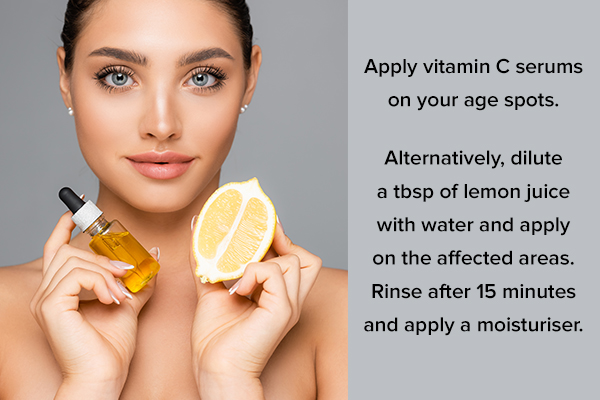
Vitamin C acts as an antioxidant that can inhibit melanin production by curbing the action of the enzyme tyrosinase. (1) It is said to help reduce age spots by various users.
How to use:
- Apply vitamin C serums on your age spots.
- Dilute 1 tbsp of lemon juice with water, and apply the solution to the affected areas. Rinse after 15 minutes and apply a moisturizer. You can also add vitamin E for a higher efficacy. (2)
2. Apply aloe vera gel
Aloe vera gel contains aloin that can help lighten the skin. (3)
How to use:
- Apply aloin-based skin whitening creams directly on the age spots.
- Extract fresh aloe vera gel and apply it to the affected areas. You can also add lemon juice to the gel. Wash your face after 20 minutes of application.
Caution: Avoid ingesting the gel as it can cause severe side effects.
3. Use natural sources of alpha hydroxy acids
Alpha hydroxy acids, including lactic, malic, and glycolic acids, work by inhibiting the activity of tyrosine, thereby inhibiting melanin production and giving a skin whitening effect. (4)(5)
While glycolic acid is commonly used for clinical chemical peels, lactic acid (6)(7) is more common in households. Lactic acid can be commonly found in yogurt, milk, milk cream, and antioxidant berries such as Indian gooseberry. (8)
How to use:
Mix any of these natural ingredients with 1 tbsp of rose water or lemon juice, and apply the mixture to the age spots.
Note: The use of apple cider vinegar is a popular anecdotal remedy. However, it mainly contains acetic acid, with minimal amounts of alpha hydroxy acid. Therefore, it might not be effective.
4. Try oils

Various oils, such as almond, rose hip, vitamin E, sandalwood, (8) and castor oil, can help inhibit melanin production, thus proving useful in the treatment of age spots. Rose hip oil contains quercetin, which is useful in depigmentation. (9)
How to use:
Dab any of the oils on the age spots using a cotton ball.
5. Dab pomegranate juice
Pomegranate juice has been shown to decrease the number of melanin-producing cells by blocking the activity of tyrosinase. It can therefore help lighten age spots. (10)
How to use:
Simply apply it to your age spots and let it dry before rinsing it off.
6. Apply rose extracts
Rose extracts have been known to block tyrosinase, thus helping lighten skin. (11)
How to use:
- Soak a few rose petals in milk for 1 hour and grind the mixture. Add honey to the paste and apply it to the age spots for 15 minutes.
- Use commercially available alcohol-based extracts as they are more effective. (12) Avoid making alcohol-based extracts at home.
7. Use honey
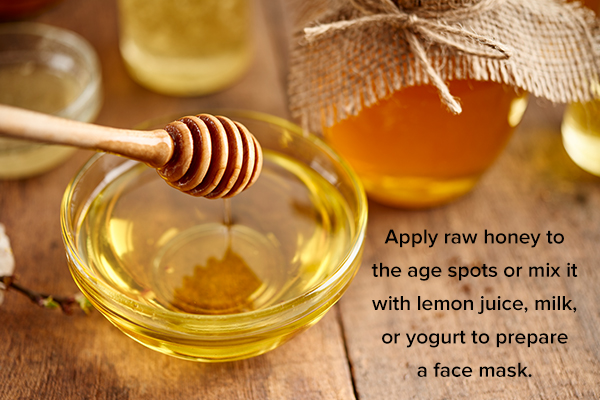
Honey contains several polyphenols that act against tyrosinase. Various kinds of honey, such as manuka, Thai, and Sardinian honey, are observed to have skin-lightening effects. (13)(14)
How to use:
Apply raw honey to the age spots or mix lemon juice, milk, or yogurt to prepare a face mask.
8. Apply a turmeric mask
Turmeric is observed to inhibit tyrosinase activity to a large extent. (8)
How to use:
Mix 2 tsp of turmeric with milk and lemon juice to form a paste. Apply the mask to the affected areas and wash it off after 20 minutes.
9. Rub a tomato
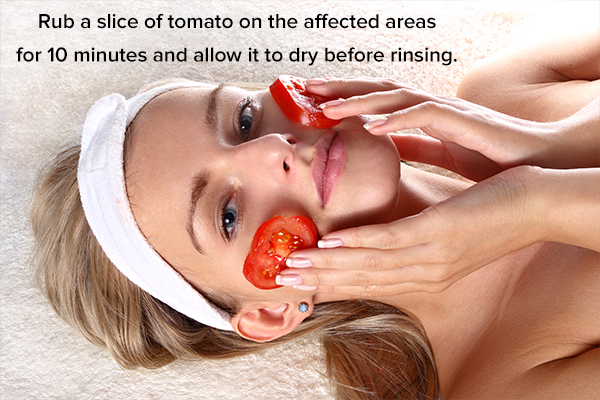
Tomato juice is a popular and safe anecdotal remedy, but its direct effect on age spots has not been studied in any research. Tomato contains lycopene that can help manage radiation damage. (15)
How to use:
Rub a slice of tomato on the affected areas for 10 minutes and allow it to dry before rinsing. Extract fresh tomato juice and use it to prepare a mask with turmeric, honey, milk, or yogurt.
10. Use OTC creams
You can apply nonprescription creams and lotions for skin lightening. Apply a cream containing vitamin E, glycolic acid, ionic acid, niacinamide, or licorice extracts. (16) These products need to be applied for months before the desired effect is achieved.
Preventive Measures for Age Spots
Follow these self-care tips to help prevent the development of age spots:
1. Apply sunscreen
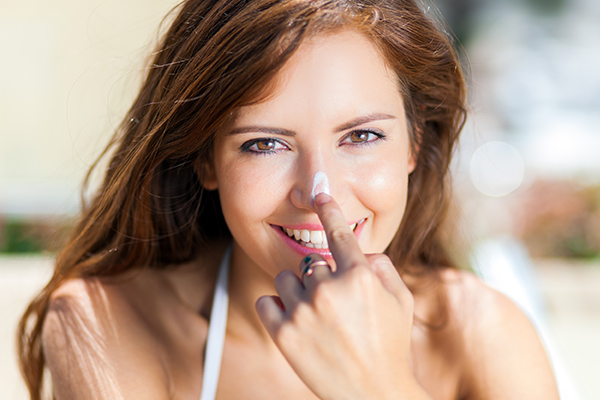
The WHO recommends wearing a broad-spectrum sunscreen with SPF 15 or higher 20 minutes before stepping outdoors. Moreover, the sunscreen should be reapplied every 2 hours or after exercising, swimming, or playing. (17)
Select sunscreens that contain zinc oxide and titanium oxide. Take note that sunscreens should be applied every day, even when it is not sunny, as UV radiation levels are not dependent on temperature.
2. Protect yourself from UV rays
Apart from wearing sunscreen, you must cover your skin with full- length clothes and wear large-brimmed hats and sunglasses to prevent sun exposure. Moreover, avoid going out during midday.
Since UV radiations are higher at higher altitudes, and snow effectively reflects UV rays, activities such as snowboarding and skiing can increase the risk of sunburn. Therefore, make sure to cover yourself well.
3. Avoid the use of tanning beds
Tanning beds use UV rays that can cause age spots and wrinkling. Instead, use self-tanning products, but make sure to continue using sunscreen with it.
4. Include antioxidants in your diet
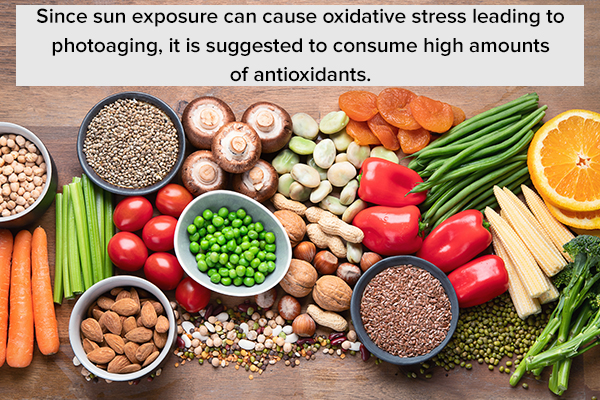
Since sun exposure can cause oxidative stress and cause photoaging, it is suggested to consume high amounts of antioxidants.
Consume leafy vegetables, citrus fruits, berries, bell peppers, beans, Brazil nuts, dairy products, oysters, whole grains, freshwater fishes, and flaxseeds for their antioxidant minerals and bioactive compounds.
Final Word
Developing age spots due to sun exposure can make you look older than you are. You can try different home remedies to help lighten these unwelcome spots and give your skin an even tone.
Moreover, you must take preventive steps to avoid the development of age spots in the first place. It is advised to consult a doctor if the age spots are large and irregular, as they may be indicative of cancer.

- Was this article helpful?
- YES, THANKS!NOT REALLY


